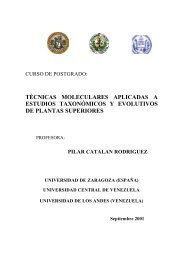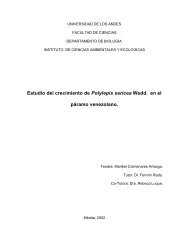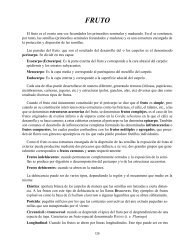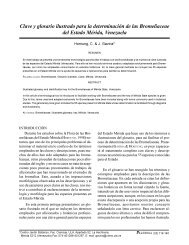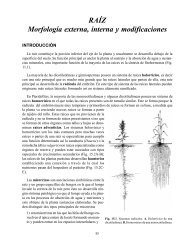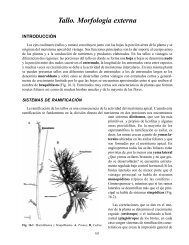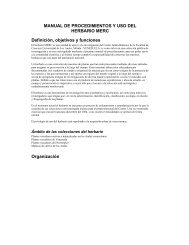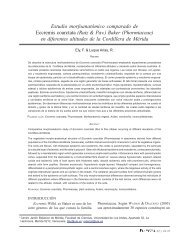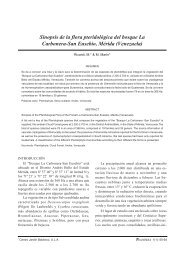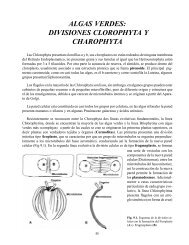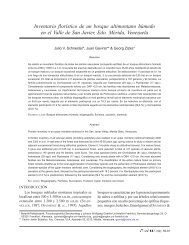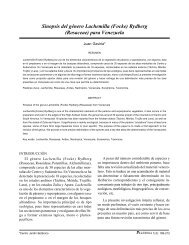Tillandsia
Tillandsia
Tillandsia
Create successful ePaper yourself
Turn your PDF publications into a flip-book with our unique Google optimized e-Paper software.
I<br />
tivel<br />
14<br />
popu rang few wid use spe pin an Sp mbe th tw<br />
B. BENNETT<br />
tion Unit Stat of spec the trop with algo has ann fru imp (Co pro me 19 of Sp up us to50 in m(Tu se toTw rea<br />
Beyond its numerous, valuable ornamental s, Bromeliaceae contains rela-<br />
dista Hor distr Thir Size (L. ran amo H. Bai fro 30 gen Ho dim Hy 19 Sp so de mtogi bemo ne 2se Pr<br />
notable exceptions. Pineapple, Ananas comosus, ranks among the most<br />
oides) was once an important source of low-grade fiber in the southeastern<br />
an undocumented amount of material continues to seU for floral arrangemeDís<br />
in the United States.<br />
different<br />
iden<br />
genera, substantially augment the hundreds of species in cultivation.<br />
sour<br />
Although<br />
of acan Till<br />
flowers<br />
cur pun usn<br />
tend<br />
The<br />
to<br />
fam and or<br />
be small<br />
rea rat oth the ep<br />
and<br />
its<br />
ephemeral,<br />
cu an ne br ze ~i<br />
unusual<br />
in thc ad ath th<br />
vegetative<br />
forms, ornamented leaves (e.g., Figs. 2.l7B, 2.18B)and brightIy pigmented<br />
floral bracts assure horticultural interest. Red, orange or yellow inflorescences<br />
of the many bird-pollinated bromeliads often signal from impressive<br />
mondii further entice hobbyists, and shade-tolerance suits many taxa for<br />
indoor cultivation. Frequent capacity to grow on a variety of substrates,<br />
inc1uding drift wood, cork slabs and fern roots, further enhances the popularity<br />
of bromeliads.<br />
Bromeliaceae figure prominentIy in several additional contexts inc1uding<br />
seis of Tarzan movies, belying the films' purported African setting. Recent<br />
appearances inc1ude Medicine Man, where Sean Connery's character finally<br />
c<br />
a<br />
m<br />
e<br />
o<br />
a<br />
p<br />
p<br />
e<br />
a<br />
r<br />
a<br />
n<br />
c<br />
e<br />
s<br />
i<br />
n<br />
S<br />
t<br />
a<br />
r<br />
T<br />
r<br />
e<br />
k<br />
m<br />
o<br />
v<br />
i<br />
e<br />
s<br />
a<br />
n<br />
d<br />
S<br />
t<br />
a<br />
r<br />
T<br />
r<br />
e<br />
k<br />
:<br />
T<br />
h<br />
e<br />
N<br />
e<br />
x<br />
E<br />
t<br />
h<br />
n<br />
o<br />
b<br />
o<br />
t<br />
a<br />
n<br />
y<br />
o<br />
f<br />
B<br />
r<br />
o<br />
m<br />
e<br />
l<br />
i<br />
a<br />
c<br />
e<br />
a<br />
e<br />
tGen<br />
7<br />
5<br />
8
treeless Bromel landsca Us of Br<br />
588 Ethnobotany of Bromeliaceae 589<br />
plain of the southeastern United States. Spanish moss, together with live<br />
oaks and magnolias, is a quintessential botanical symbol of the old<br />
American South.Yet above ismuch 3000 more m(Benn than asource 1988, of pineap 1990, 1991) house Resid plant pine Tab 14. (An Co com ind su inno na So th<br />
enous member has Below, continu manage 1discuss of this inmy family indigen of work Brome furnish with taxono the food, Shuar, fiber based nonho Quich and on inspir data and from Chach uses for my folklo inEcua field and indig notes for fasc asho<br />
America<br />
(Sou<br />
and fibers for traditional cultures, a fact 1 began to appreciate in the high-<br />
199 14.1 Pine Ben Am cho 197 Tutri is 199 the<br />
the Bor latt ind mo Piñ term 197 wid and me Of oth lla alla use anW19 lar bro are lar de ch arb (B19 fro (Cch anmof br thSp Sc ac wf (C<br />
Group Common llame Source<br />
lands of southern Peru. Bromeliads are significant elements of the mostIy<br />
Chachi chilla Bennett, field notes<br />
Cofan chiviya Borman 1976<br />
Quechua distinguish folk taxa of Bromeliaceae, some of which provide<br />
Quichua chihuilla Orr and Wrise1y 1981<br />
fuel, animal forage, medicine and ritual ornamentation. Children make<br />
trial brom<br />
Quechua<br />
thro the<br />
chihuy<br />
An an we<br />
Soukup<br />
ARll<br />
1970<br />
Tikuna chi-ná Schultes and Raffauf 1990<br />
whistIes from bromeliad leaves, and their parents decorate weddings and<br />
Shuar chiu Bennett et al. 1999<br />
funerals with certain species. The discovery of folk usage and nomenc1ature<br />
and the SeminQle in Florida. Each of these indigenous peoples has a folk<br />
taxonomy tailored for local Bromeliaceae. While not essential for survival,<br />
many traditional Neotropical cultures.<br />
Vriesea The Tzeltal llame for Tilland usneo is?icib, which isunre- for as Chil terre and Arg spe The Ach Sh<br />
llames in northwestern South America are related linguistically (Table<br />
and publications (Bennett 1986b, 1990, 1992a, 1995, 1997a,b, Bennett et<br />
reata<br />
widely<br />
and<br />
used<br />
several<br />
species,<br />
Tilland<br />
and describes<br />
species<br />
the<br />
but<br />
range<br />
k'utha<br />
of derived<br />
isused<br />
produCíS<br />
for Tusneo<br />
and appli-<br />
(Alcorn<br />
cations.<br />
Ashome while qaka ageneric 1984). sunka Hicund llame refers is toTusneoi the Quech and term other for most dimin Tillan saxic of lla Br is als for us ep co an so bu mo te<br />
chihuilla (Quichua), chihuy (Quechua), chiu (Shuar) and chi-ná (Tikuna)<br />
pineapple (piña), is commonly applied to bromeliads in Central America<br />
and parís of South America.<br />
Huicunto and cognates commonly denote epiphytic and certain terres-<br />
Folk<br />
for<br />
taxonomy<br />
epiphy<br />
of<br />
refers<br />
Bromeliaceae<br />
specif<br />
including huicundo, huiccontoi, huacontoi, huaycontoy, guicundo and<br />
Designations inc1ude such contrasts as attractive/ugly, friendly/hostile,<br />
hicundo (Soukup 1970;Joyall987; Bennett 1990)are employed as far south<br />
edible/poisonous. Although members of modern societies make these distinctions<br />
daily, c1assification is even more important for indigenous people,<br />
and it extends beyond simple dichotomies. The Tzeltal ethnobotanical<br />
bromeliads is kuish (Bennett et al. 1999).Us<br />
study of Berlin et al. (1974) presents the most comprehensive analysis of<br />
bromeliad folk c1assification. The Tzeltal ?ecE' refers to members of several<br />
bromeliad genera, including Aechmea, Catopsis, Pitcairnia, <strong>Tillandsia</strong> and<br />
Nine, nonexclusive categories of plant uses apply to Bromeliaceae (fiber,<br />
food, forage, fuel, medicine, ornamental, ritual/mythical, miscellaneous,<br />
Quichua nomenclature. K'ok'om is the Huastec llame for Aechmea brac-<br />
cornmercial; based on Bennett et al. 1999). These categories reflect local<br />
applications and perceptions, and mar not always coincide with Western<br />
notions of utility. For example, indigenous people consider fruits eaten by<br />
monkeys, or trees inhabited by spirits, to be useful species.<br />
(Bennett 1990). The Seminole in Florida differ in their classification.<br />
The fiber category includes bromeliads that provide clothing, thread,<br />
rape and paper. Food and forage groups contain plants consumed by<br />
l<br />
a<br />
t<br />
e<br />
d<br />
l<br />
i<br />
n<br />
g<br />
u<br />
i<br />
s<br />
t<br />
i<br />
c<br />
a<br />
l<br />
l<br />
y<br />
t<br />
o<br />
?<br />
e<br />
c<br />
E<br />
'<br />
.<br />
A<br />
s<br />
i<br />
m<br />
i<br />
l<br />
a<br />
r<br />
p<br />
a<br />
t<br />
t<br />
e<br />
r<br />
n<br />
o<br />
c<br />
c<br />
u<br />
r<br />
s<br />
i<br />
n<br />
H<br />
u<br />
a<br />
s<br />
t<br />
e<br />
c<br />
a<br />
n<br />
d<br />
a<br />
l<br />
.<br />
1<br />
9<br />
9<br />
9<br />
)<br />
a<br />
n<br />
d<br />
o<br />
t<br />
h<br />
e<br />
r<br />
r<br />
e<br />
l<br />
e<br />
v<br />
a<br />
n<br />
t<br />
l<br />
i<br />
t<br />
e<br />
r<br />
a<br />
t<br />
u<br />
r<br />
e<br />
.<br />
T<br />
h<br />
i<br />
s<br />
r<br />
e<br />
v<br />
i<br />
e<br />
w<br />
i<br />
d<br />
e<br />
n<br />
t<br />
i<br />
f<br />
i<br />
e<br />
s<br />
t<br />
h<br />
e<br />
m<br />
o<br />
s<br />
t<br />
an it cR<br />
toTusneo T
nity.Usefulhorticulsonous. tions, ceremon includin Other brameli The utility. species those miscell Many are yield associa listed posses fuel, inTable despite catego with medic huntin 14.2. the encom absen At praper least fishin of 90 wood all speci perso and other two tissue have appli are matte nonpoi- The ¡:¡..<br />
~<br />
""<br />
()<br />
'"<br />
~("-I("-I<br />
"("-1("-1«')«')'-00
Catop Guzm Neogl Guzm<br />
wang Mez &Werc<br />
Pitcai sphac acum eduar mono sangu musa<br />
MezGreig (Ruíz Andr (Lind LB. &Pavó exMez Smit Rege<br />
Table 14.2. (cont.)<br />
Referenceb<br />
Species<br />
Greigia sodiroana<br />
Guzmania melinonis Rege1Guzm (And (L) &And Rusb And exMez<br />
Pitcai breed pung varie H.B. LB. (Arru Smit Mez exMez Mez CO<br />
DistributionaME<br />
UnSA, AB<br />
LCOS<br />
Pitcai spica (Lam Mez<br />
XME EC toPA toBO TR TORFOMFMO<br />
Puya Puyaf Puya chilen (Lind Mo1i (Ruíz &Pavó E. Morr LB. exMez Smi<br />
Pitcairnia angustifolia Aiton<br />
Pitcairnia heterophylla Beer<br />
Pitcairnia<br />
Puya<br />
hama lasiop medic longi<br />
integrifolia Ker-Gawl.<br />
Pitcairnia maidifolia (c. Morren) Decasine<br />
in P1anchon<br />
Pitcairnia (Pepinia) pulchella Mez<br />
Pseudananas sagenarius (Arruda) Camargo<br />
Puya gigas AndréPuya Puya oxyan LB. LB. Mez LB. Mez Smit Smit<br />
Puya pyram (R. Smit BO<br />
IHO toCO toVE<br />
RECU<br />
UCO BR toPER &SU &PE PA AR<br />
11<br />
IECU<br />
36<br />
PER BO<br />
21<br />
COS CO VE &BR<br />
x<br />
LCO<br />
6,8<br />
EC PE<br />
6,7,8,x<br />
6,7,8, x<br />
26<br />
26<br />
CM,FI<br />
15,21,27<br />
3<br />
11<br />
24<br />
3<br />
26<br />
Puya Tillan Puya Tillan Roem sodir raimo webe bifior capil carls &Schu Harm Mez Ruíz Mez Ruíz LB. &P) &Pavó Smit Schu in<br />
35<br />
36<br />
3<br />
12<br />
14,21<br />
Tillan<br />
fascic dasyl chart LB. Sw. LB. Smit<br />
r--<br />
Tillan<br />
Tillan<br />
Tillan lamp macu maxim oroge guate incar (Ruíz Lillo Stand Ruíz H.B. LB. &Pavó &Haum LB. &Pavó Smit &LO. Smit PER CO<br />
Poir ME CO BO toBR<br />
Will<br />
XUS,<br />
RGA<br />
XCO tonw BO toCA CH &BO SA BR ARFR<br />
FM<br />
17<br />
35<br />
26<br />
10,35<br />
x<br />
Puya sp.<br />
Tillan oroye Mez ME CA WI tonSA<br />
Streptocalyx<br />
pond<br />
(Aechmea)<br />
LB.<br />
longifolius<br />
Smit PER BO AR<br />
(Rudge) Baker<br />
<strong>Tillandsia</strong> benthamiana K1otzsch ex Baker<br />
Tillan purpu Ruíz &Pavó ME<br />
RME<br />
GME GA<br />
RME GU toCO toNIC toCA toBO SAFOMR<br />
COR FOR<br />
x<br />
FR,FU<br />
10,35,36<br />
17,x<br />
14,31<br />
5, 17 M<br />
<strong>Tillandsia</strong> complanata Benth.<br />
<strong>Tillandsia</strong> erubescens Sch1ect.<br />
11,36<br />
<strong>Tillandsia</strong> gilliesii Baker<br />
26<br />
<strong>Tillandsia</strong> ionochroma André ex Mez<br />
5,7<br />
18<br />
C<br />
O<br />
L<br />
,<br />
E<br />
C<br />
U<br />
E<br />
C<br />
U<br />
,<br />
P<br />
E<br />
E<br />
C<br />
U<br />
,<br />
P<br />
E<br />
R<br />
V<br />
E<br />
N<br />
,<br />
T<br />
R<br />
E<br />
C<br />
U<br />
,<br />
P<br />
E<br />
R<br />
B<br />
O<br />
L<br />
,<br />
A<br />
R<br />
E<br />
C<br />
U<br />
C<br />
H<br />
I<br />
C<br />
O<br />
L<br />
,<br />
E<br />
C<br />
U<br />
C<br />
O<br />
L<br />
,<br />
E<br />
C<br />
E<br />
C<br />
U<br />
C<br />
O<br />
B<br />
R<br />
A<br />
L<br />
A<br />
M<br />
E<br />
M<br />
A<br />
E<br />
C<br />
M<br />
E<br />
M<br />
E<br />
X<br />
C<br />
O<br />
L<br />
,<br />
P<br />
E<br />
M<br />
E<br />
P<br />
E<br />
C<br />
O<br />
C<br />
H<br />
P<br />
E<br />
R<br />
P<br />
E<br />
R<br />
P<br />
E<br />
R<br />
P<br />
E<br />
R<br />
P<br />
E<br />
R<br />
B<br />
O<br />
L<br />
,<br />
P<br />
E<br />
R<br />
E<br />
C<br />
U<br />
P<br />
E<br />
R<br />
,<br />
B<br />
O<br />
L<br />
P<br />
E<br />
R<br />
31 F<br />
36 M<br />
x F<br />
35 F<br />
x F<br />
35 M<br />
5,6,7 O<br />
11 O<br />
30 F<br />
35 F<br />
11 O<br />
20 F<br />
33 R<br />
11 O<br />
11 O<br />
11 O<br />
33 R<br />
10 F<br />
11 O<br />
17 F<br />
11 O<br />
O<br />
R<br />
,<br />
R<br />
M<br />
C<br />
M<br />
,<br />
F<br />
O<br />
C<br />
M<br />
,<br />
F<br />
O<br />
F<br />
R<br />
F<br />
R<br />
,<br />
O<br />
R<br />
,<br />
R<br />
M<br />
R<br />
,<br />
R<br />
M<br />
R<br />
,<br />
R<br />
M<br />
R<br />
,<br />
R<br />
M<br />
R<br />
,<br />
R<br />
M<br />
R<br />
,<br />
R<br />
M<br />
R<br />
,<br />
R<br />
M<br />
R<br />
,<br />
R<br />
M<br />
I<br />
R<br />
M<br />
,<br />
M<br />
E<br />
,<br />
M<br />
I<br />
U<br />
s<br />
e<br />
s<br />
C<br />
U<br />
E<br />
M<br />
E<br />
O<br />
R<br />
,<br />
R<br />
M<br />
M<br />
E<br />
M<br />
E<br />
O<br />
R<br />
O<br />
R<br />
O<br />
R<br />
R<br />
R<br />
M<br />
M<br />
M<br />
E<br />
E<br />
F<br />
R<br />
M<br />
E<br />
M<br />
E<br />
F<br />
O<br />
F<br />
I<br />
,<br />
M<br />
E<br />
F<br />
R<br />
M<br />
E<br />
O<br />
R<br />
,<br />
M<br />
I<br />
F<br />
O<br />
F<br />
R<br />
O<br />
O<br />
R<br />
O<br />
O<br />
O
:ir:i¡¡"<br />
~~o¡¡:¡ ~00 ~o~ ¡¡~¡¡.. ~00 ~o~ ~¡¡:¡ or:i r:i~<br />
~N::::: r--o~::i ~-..,f.~-<br />
~~\C)<br />
8 ,..$ "'o 00-00","0::><br />
i:)"" gO\~~éi::e¡¡..<br />
:::0 OO'l~M .o "'r-->'"<br />
-- o~<br />
<<br />
8<br />
~<br />
O<br />
~<br />
-<br />
,<br />
:<br />
,<br />
o<br />
o<br />
o<br />
e<br />
"<br />
"<br />
~<br />
e<br />
~<br />
B<br />
&<br />
:<br />
b<br />
;<br />
t<br />
=<br />
-<br />
°<br />
~<br />
-<br />
§<br />
¡<br />
¡<br />
"<br />
~<br />
U<br />
c<br />
ñ<br />
"<br />
O<br />
~<br />
-<br />
~<br />
-<br />
'<br />
:<br />
:<br />
:<br />
"<br />
'<br />
o<br />
e<br />
e<br />
"<br />
'<br />
"<br />
o<br />
N<br />
0<br />
,<br />
"<br />
"<br />
,<br />
-<br />
'<br />
0<br />
"<br />
"<br />
~<br />
r<br />
J<br />
)<br />
O<br />
'<br />
I<br />
~<br />
"<br />
"<br />
"<br />
'<br />
O<br />
'<br />
N<br />
;<br />
:<br />
3<br />
-<br />
.<br />
:<br />
0<br />
0<br />
e<br />
"<br />
O<br />
"<br />
'<br />
~<br />
c<br />
.<br />
.<br />
°<br />
'<br />
-<br />
o<br />
-<br />
.<br />
0<br />
'<br />
1<br />
.<br />
-<br />
t<br />
E
596<br />
Us 01 Br<br />
Ethnobotany 01 Bromeliaceae 597<br />
enae Aechme Figure fibers 14.1. magdal and Bramel sitting leaves. on uses. ahammo (B) (A) AQuijos<br />
made Quich<br />
fram the man woma plant. comb extrac Aechm fibers magd fram com lecte cenc Figu is for 14.2 edib fibe fuel Bra (C) (B) (D) Puy Infl Till use rai (co usn of gra Ae (ASh an in soPe oth ma (cba Ti Th sp mfrA lebac min (i b<br />
being sold for Christmas decorations in Quito, Ecuador.
'T~e~e frmt icate mthe fragran were shape some [and] of [fruits] apille excelle like Calle, articho twice flavor' as plants (Purse big, which but four fruit 1972) times is excel As as tall, with whic and other it New (Laf<br />
the tropics. Today, we associa the fruit with Hawa but the Hawa sum inBol et al. 199 and Arg Sho Us api 01 (B19 Br of Tma HQd an Tru ac<br />
598 Ethnobotany 01 Bromeliaceae<br />
plant pineapp<br />
like the Irish patato, origina inSouth Amer Hawa did<br />
tus, A. through lucidus Ananas A. the paragu isderived New World from and the tropics Tupí-G Pseud by the time langu sagen Colum an<br />
( Purseglove<br />
whic idiom arriv<br />
1972)<br />
also still zebr<br />
599<br />
Pineapple also impressed other European explorers. Oveido wrote in bis<br />
Historia General y Naturales de las Indias, of 1535, '[t]here are no other<br />
fruits in the whole world to equal them for their beauty of appearance, del-<br />
World<br />
growing<br />
domesticates, Spanish explorers carried pineapples to all corners of<br />
to1500 between<br />
not receive its first pineapples until the early 1800s.<br />
mented mID. best pineapp<br />
Pineapple probably originated in the Paraná-Paraguay River drainage<br />
system (Purseglove 1972). Indigenous peoples were already cultivating the<br />
Resemblance to a pille Calle (piña in Spanish) prompted the English llame<br />
spoken in Paraguay and southern Brazil. Ananas ananassoides, A. bractea-<br />
yield edible fruits, are all possible ancestors of the pineapple (Brücher<br />
1989). Certain species of Aechmea, Bromelia and Greigia also bear edible<br />
fruits (Fig. 14.2B).Today, also often made eaten beverag 635 from fresh, Howev and betwee Aechm 2500 ismade but ranks 25' mm crops much freID Nand magda among and can of pineap frost surviv the Slatitud the comm is most absent Brome where fruits where widely (Purse inPanam alsod harve rainfa annua cultiv precip B. range is (Duk 1972) canne hemis tropic from Fruit 1986 Afer- fruits terre<br />
B. nidus-p B. pinguin and B. plumie fruits (von Reis and Lipp 1982 1000 Altc Guz Mo eat acu the you G. inf edu G. me an dr an wim Gm<br />
water trapped in the phytotelmata of <strong>Tillandsia</strong> oroyensis (Franquemont et<br />
al. 1990) much as the Seminole of southern Florida once used <strong>Tillandsia</strong><br />
utriculata (Bennett, field notes).<br />
Alcorn 1984; Duke 1986; Mabbe 1987) Selle indige Ame falls<br />
consum bromel leaves and merist The tender leaf bases of Puya and are use rela van Rei Puy and sod Lip 19 is a'fa pr th foof raAsp be (vR<br />
Forage<br />
mel enou toxi pois hos skin frog sec tokill ass pro peo the hun (Pe by aco the 19 an Kowb su to ar of<br />
by numerous species including Aechmea tessmannii, A. tillandsioides, A.<br />
and many forest people in turn eat these primates (Fig. 14.3A). Hunting is<br />
more successful where forest canopies host abundant phytotelm<br />
Bromeliaceae. Other animals also depend on these plants and Selle of their<br />
cled bear (Tremarctos ornatus).<br />
hamata Asweet in Altchul and souther Tilland are drink eaten Ecuado is The compla concoc in Pilla salad (Benzi sand of from leaves Mexic 1980). ground young are occasi Leaf into inflore used bases flour towrap of (von eat P. T. sodiro and Reis tamal erube soft Altch<br />
Dendrobatid frogs inhabit the tanks of Selle epiphytic bromeliads. Most<br />
leaf are (von tissue<br />
indigenous people tip poison darts with phytotoxins (often species of<br />
edibl<br />
Loganiaceae and Menispermaceae), but inhabitants of Colombia's Chocó<br />
and Reis T. field coll cons Mul<br />
One dendrobatid species is so potent that a single individual contains<br />
tutes.Sco eat of Pep oth pul ani con lea (vo bro Re A19 gi tho ag<br />
stre seed web feed biflo Till rec sho (M19 NAp<br />
197 note on of Ben the T. brom P. cha foli lasi tohelp (vo amo 198 Rei of rais inc T. van P. Puy oth fas Alt dom oxy Re fer (vo Pu and 19 an Re T. Lip soP. ion gu P. Fr P. Al we pyPsoaP 19 pi Be 19 T. Ca wT spaT et Sm al sh 19 19 an 1fi ath ll<br />
throughout much of Amazonia. Fermented and nonfermented drinks are<br />
notes; Franquemont et al. 1990).<br />
recurvata inflorescences, apparently attracted by the high sugar content<br />
c<br />
u<br />
t<br />
w<br />
i<br />
t<br />
h<br />
a<br />
k<br />
n<br />
i<br />
f<br />
e<br />
l<br />
i<br />
k<br />
e<br />
a<br />
t<br />
u<br />
r<br />
n<br />
i<br />
p<br />
a<br />
n<br />
d<br />
i<br />
t<br />
s<br />
e<br />
e<br />
m<br />
s<br />
t<br />
o<br />
b<br />
e<br />
w<br />
h<br />
o<br />
l<br />
e<br />
s<br />
o<br />
m<br />
e<br />
.<br />
'<br />
e<br />
can gave ba<br />
..<br />
danim<br />
A<br />
t<br />
l<br />
e<br />
a<br />
s<br />
t<br />
2<br />
1<br />
s<br />
p<br />
e<br />
c<br />
i<br />
e<br />
s<br />
p<br />
r<br />
o<br />
d<br />
u<br />
c<br />
e<br />
f<br />
o<br />
r<br />
a<br />
g<br />
e<br />
s<br />
u<br />
i<br />
t<br />
a<br />
b<br />
l<br />
e<br />
f<br />
o<br />
r<br />
d<br />
o<br />
m<br />
e<br />
s<br />
t<br />
i<br />
c<br />
a<br />
t<br />
e<br />
d<br />
o<br />
r<br />
w<br />
i<br />
l<br />
bl cu sd<br />
(F14 an BD
Us of Br<br />
600 Ethnobotany of Bromeliaceae 601<br />
r<br />
o<br />
"<br />
"<br />
"<br />
"<br />
"<br />
~<br />
inflores Figure foods of 14.3. the Brome! woolly in apatch monke uses of terrestr (Lagot (contin specim lagoth (A) Brom (B) shown Leaf are bases here one forag of<br />
Puya the for raim prefe youn guIn (B) or~t Tilla 14.4 pig in the (cui Bro iono hig feed (D) use kno of Hu (co Per as (CPu hu ayo (ATi inQu we Qu spka bo isus se wawm as ar awd co f<br />
Figu<br />
aya huicunto in Quechua, is used as a funeral decoration in the highlands of Perno<br />
collected for fue! in Perno<br />
.......<br />
frollI a <strong>Tillandsia</strong> ionochroma leaf.
the Soukup souther and southea coastal 1970). Andes, deserts Puya United assume of weberb Peru States, except and Ecuad P. adomin weber impor (Benn specie flouri field for on valley notes this in reaso the slope Rowe resul in 1963 Leaf the chol (pro flo of bil de di (cp<br />
602 Ethnobotany 01 Bromeliaceae<br />
Fue!<br />
Several species each in <strong>Tillandsia</strong> and Puya provide fuel in the high Andes<br />
At ignites. least The 25 bromel highlan Quech species posses of southe purpo Peru therap use the leaf prope bases of P. not rai- leav indom appl and brok frui are use (So hall todisi ani Hu 197 (A19 Ay wo use the 19M19 sam (vo pla Ba Re an to po co Li A1D 19 of fu Bc in ad<br />
Uses 01 Bromeliaceae<br />
603<br />
powerful abortifacient. Serotonin, a vasoconstrictor, further characterizes<br />
this fruit. Antihelmintic (vermifuge), antiscorbutic (treatment for scurvy),<br />
spiration), diuretic, ecbolic (smooth muscle stimulant), emmenagogic<br />
(agent that increases menstrual flow), purgative and refrigerant (relieving<br />
bases and stems burn long and hot. Villagers near Cuyo-Cuyo, Peru set tires<br />
to enhance the growth of this terrestrial bromeliad. Like Serenoa repens in<br />
employ phytote<br />
open habitat.<br />
for headac of Aechm<br />
Burning destroys<br />
dizzine bracte<br />
foliage<br />
eye to troubl treat rever.<br />
and eliminates<br />
and upset The same fluid are<br />
competing<br />
stoma<br />
species,<br />
cause relie that of<br />
rever or<br />
cram Car<br />
producing<br />
(Du pap<br />
cooling<br />
198 for tre<br />
sensation)<br />
Tri oe<br />
activities<br />
fro Br<br />
are algo<br />
pl<br />
attributed<br />
lea<br />
to pine-<br />
1986; Schultes and Raffauf 1990; Bennett et al. 1999). Steroids from pineapple<br />
foliage possess oestrogenic activity.<br />
Boiled, young Bromelia alsodes leaves serve as a poultice to treat trauma<br />
but the rhizomes survive. Fire algo promotes rapid regrowth, which may be<br />
more palatable to domesticated animals. Charred leaf bases are easier to<br />
collect after their spiny leaves have been removed, and this material readily<br />
.Bromel<br />
mondii in similar fashion (Figs. 14.2C,14.3B).<br />
is current market byWillia H. Rorer Inc. under the llame<br />
Medicine<br />
promote 1982). wound healing (Physi Desk Relere 1984; Hens<br />
a surprising<br />
Apoultice<br />
number<br />
of<br />
considering<br />
young leaves<br />
that<br />
is<br />
indigenous<br />
applie to<br />
cultures<br />
sprain<br />
tend<br />
(Aye<br />
to use<br />
1981 rubb edly (Ay spec Two pitc The whi foli gen tric Pit of Pi an Pu an co sem<br />
retic and vermifuge are prepared from its fruits (Morton 1981). Bromelia<br />
nidus-puellae berries possess antiscorbutic properties (Duke 1986).<br />
Bromelia pinguin, like pineapple, contains bromelain with effects similar to<br />
Aprep help on 198 ven con An from dys infu Pu inma chi of (M19Wpo yo (A19 isus Pi as ahe he Ainmfr an (p le ae re tr<br />
bronchitis, lung congestion, intestinal parasites and rheumatism (Ayensu<br />
1981;Morton 1981;Núñez Meléndez 1982). Fruits are reported to be anti-<br />
larger<br />
scorbutic and diuretic, and capable of causing blood to flow more freely to<br />
portions of local floras for medicines than for any other purpose (e.g.,<br />
Bennett et al. 1999). Subfamily Bromelioideae contains the largest number<br />
applied to burns (von Reis Altchu11973; Morton 1981).<br />
of medicinal species. The Huastecs of Mexico drink water drawn from the<br />
min mad<br />
lEcu 197 from<br />
spicata<br />
Puy Van Rei flow<br />
are mixed<br />
(So con and is Lip<br />
with<br />
197 app Pu (19<br />
honey<br />
Ch sod tohe no<br />
to treat<br />
Ve the sh (CV1Ale tre<br />
thrush and<br />
19<br />
to tre of pnwa<br />
to heal cut umbilical cords<br />
from 'eating toa many chiles' (Alcorn 1984). Lowland Quichua in Ecuador<br />
allow children to inhale vapors from boiling A. zebrina leaves to relieve<br />
insomnia (Alarcón 1988).<br />
chome shields) from the abaxial surfaces of Pitcairnia integrifolia leaves is<br />
Ananas comosus has medical utility attributable to the presence of brom-<br />
ground Pitcairnia pungens root is used for kidney and liver ailments, and<br />
the cooked mixture works as a diuretic (von Reis and Lipp 1982).<br />
Ananase to treat inflammation and related pain. Topical applications algo<br />
Rural people apply pineapple juice for similar purposes (Núñez Meléndez<br />
decoction of Puya floccosa has purgative properties (von Reis Altchul<br />
Pineapple is algo used to treat jaundice, ulcers, intestinal ailments, sore<br />
throats, urinary problems and dyspeptic flatulence. Sweetened juice pro-<br />
(Benzing 1980). Peruvian highlanders alleviate throat inflammation, ear-<br />
Venezuela. Juice expressed from the vegetative buds is ingested to treat resaches,<br />
fiase bleeds and swellings withjuice from the flowers of an undeterpiratory<br />
ailments, and that from unripe pineapples supposedly works as a<br />
.<br />
m<br />
o<br />
t<br />
e<br />
s<br />
d<br />
i<br />
g<br />
e<br />
s<br />
t<br />
i<br />
o<br />
n<br />
a<br />
n<br />
d<br />
p<br />
r<br />
e<br />
v<br />
e<br />
n<br />
í<br />
s<br />
s<br />
e<br />
a<br />
s<br />
i<br />
c<br />
k<br />
n<br />
e<br />
s<br />
s<br />
a<br />
c<br />
c<br />
o<br />
r<br />
d<br />
i<br />
n<br />
g<br />
t<br />
o<br />
s<br />
o<br />
m<br />
e<br />
u<br />
s<br />
e<br />
r<br />
s<br />
i<br />
n<br />
e<br />
l<br />
a<br />
i<br />
n<br />
,<br />
a<br />
p<br />
r<br />
o<br />
t<br />
e<br />
o<br />
l<br />
y<br />
t<br />
i<br />
c<br />
e<br />
n<br />
z<br />
y<br />
m<br />
e<br />
s<br />
i<br />
m<br />
i<br />
l<br />
a<br />
r<br />
t<br />
o<br />
p<br />
a<br />
p<br />
a<br />
i<br />
n<br />
f<br />
r<br />
o<br />
m<br />
C<br />
a<br />
r<br />
i<br />
c<br />
a<br />
p<br />
a<br />
p<br />
a<br />
y<br />
a<br />
s<br />
t<br />
e<br />
m<br />
d<br />
e<br />
c<br />
o<br />
c<br />
t<br />
i<br />
o<br />
n<br />
f<br />
r<br />
o<br />
m<br />
t<br />
h<br />
e<br />
a<br />
p<br />
t<br />
I<br />
y<br />
n<br />
a<br />
m<br />
e<br />
d<br />
P<br />
u<br />
y<br />
a<br />
m<br />
e<br />
d<br />
i<br />
c<br />
a<br />
.<br />
S<br />
o<br />
m<br />
e<br />
r<br />
u<br />
r<br />
a<br />
inre c<br />
an P<br />
ki a
with Ecuado cences amedica the Tilland more alcohol (Benne wide1y treat is derived earache taken emp10 fie1d a1so each notes). from include with mornin Tilland Tcapilla An juice import infusio to from cure (Franq medic of Guzm isTrecur anemi Tillan or specie mono kidne benth et its al. uti1it The 1990 troub Chac inflo inclu One mixe (von of Tilla 198 Mé1 spe (19 by the 199 Le Us des 01 of Ho the us Sh of seCa at uf<br />
water head infusion of crushed Tschied 1eave and app1y the fo1ia to the<br />
604 Ethnobotany 01 Bromeliaceae<br />
Peru to relieve rever and headac (Alcor 1984)<br />
Reis<br />
acontrac<br />
Altchul1973). High1and Quechua speakers in Peru treat coughs with<br />
decoctio Huastec treat women of dandru Tilland drink but with consid adecoct xiphioi arinse this flower made practic from<br />
report dange ahandf this p1ant dimin (Alco of (Ben Tusneo chest 1990 raiD as lata fune and wer Tiono use of towra bro (Be som is lon Pe 19 Bo mu sp Ti (T19 ar ca gi hin an Tm th<br />
605 Br1<br />
lllaize-p1anting ritua1s to the resemb1ance between the immature inflorescences<br />
and young corn sta1ks and to the exceptiona110ngevity of dis10dged<br />
epiphytes in dry environments such as an altar.<br />
Severa1 <strong>Tillandsia</strong> species serve contrasting purposes in southern Peru.<br />
(Usher 1974), and hot baths made from severa Tillan speci reduc<br />
High1and Quechua speakers adorn wedding sites with <strong>Tillandsia</strong> biflora<br />
treatments of hemorrhoids, gallb1adder afilictions and menstrua1 irregu1arities<br />
(Morton 1981; Núñez Me1éndez 1982). The Huastecs drink a co1d<br />
indigenous idiom, and display shiny red or green 1eaves. The'Quechua place<br />
Many<br />
<strong>Tillandsia</strong><br />
of the<br />
usneoides<br />
bromel<br />
is the<br />
emplo<br />
most wide1y<br />
in re1igi<br />
distributed<br />
festiv<br />
bromeliad,<br />
posse<br />
hence,<br />
ornam<br />
not<br />
surprising1y,<br />
tal and ritual<br />
the<br />
va1ue.<br />
species<br />
Co1um<br />
with the<br />
report<br />
most<br />
that<br />
varied<br />
some<br />
medicinal<br />
Nativ Amei<br />
utility. Its<br />
hung hard Jam et (Ben al.<br />
ash-co10red<br />
1im 199 Ki1 fiel of Hig<br />
<strong>Tillandsia</strong><br />
har not des tim Fig Qu<br />
sphaerocephala<br />
in 14. Tusn afrin spe Tz sh as se 'an spha<br />
shoots<br />
(B T. inan us<br />
on<br />
anW1 Tina Tuo in<br />
caskets at funeral s,<br />
perhaps to signify death. Its Quechua llame, aya huicunto, means death or<br />
soul bromeliad (Fig. 14.4A,B). According to the archaeo10gical record, the<br />
uses<br />
include treatments for coughs, rever, hemorrhoids, hernias, meas1es, mouth<br />
sores, rheumatic arthritis, sores, and ai1ments of the 1ung, 1iver, kidney and<br />
<strong>Tillandsia</strong> usneoides serves as a Christmas ornament throughout Latin<br />
heart (Burlage 1968; Soukup 1970; Chávez Ve1ásquez 1977; Núñez<br />
America (Fig. 14.2D), often in nativity scenes as the bed for the Christ<br />
Meléndez 1982; Alcorn 1984; Moerman 1986). The high1and Quechua of<br />
figure (Berlin et al. 1974; Alcorn 1984; Bennett 1990, 1995; Franquemont<br />
Aechme tomes of Catops religiou officia Pitcair and Tillan a10ng and religio Vriesi shrine on doorw in their of own the<br />
several other species during the Christmas season in Quito, Ecuador<br />
discomfort associated with neuritis (Steele 1964).<br />
same with Guzma eduard G. melino and G. mono (Ben et puel Add use fit Do of the cat de so faFe<br />
doorways during celebrations (Ber1in et al. 1974). Most important,<br />
perhaps, is its cultural significance in the southern United States: co1umnist<br />
198 Duk B. plum 198 An and ass Pu gig foo pro or fib ga pr fr<br />
ible part of the Southern character; it b1urs, concea1s, softens, wraps the<br />
Ornamental and rituallmythical<br />
Miscellaneous<br />
crowns of pineapp1e 1eaves ayer the entrances to their houses as a sign of<br />
hospita1ity, a tradition that continues in Europe and North America.<br />
Carib warriors in the West Indies produced an arrow poison from decaying<br />
Pineapp1e motifs are carved on doorways and gateposts as welcome signs<br />
pineapp1e fruits (Haughton 1978). Llipta, a substance obtained from the<br />
(Haughton 1978). Tzelta1 speakers in Mexico suspend specimens of<br />
(Franquemont et al. 1990), yie1ds the a1kalinity needed to release the active<br />
constituents from chewed coca 1eaves (Erythroxylum coca). Living felices<br />
househo1ds (Berlin et al. 1974).<br />
constructed of Aechmea magdalenae, Ananas comosus, Bromelia nidus-<br />
Immigrants from the sierra and indigenous Quichua place Aechmea tessmannii,<br />
A. tillandsioides and A. zebrina on trees around their 10w1and<br />
houses from marauders (Bennett, fie1d notes; Pérez-Arbe1áez 1956; Morton<br />
Ecuadorian tomes (Bennett, fie1d notes). The Ecuadorian Shuar do the<br />
bonus.<br />
al., 1999). Huastecs decorate their fiesta sites with Bromelia alsodes (Alcorn<br />
Quechua chi1dren make whistles from the 1eaves of <strong>Tillandsia</strong> ionochroma<br />
1984 A<br />
an co a<br />
~<br />
a<br />
s<br />
h<br />
o<br />
f<br />
m<br />
a<br />
n<br />
y<br />
b<br />
r<br />
o<br />
m<br />
e<br />
1<br />
i<br />
a<br />
d<br />
s<br />
,<br />
i<br />
n<br />
c<br />
l<br />
u<br />
d<br />
i<br />
n<br />
g<br />
d<br />
r<br />
i<br />
e<br />
d<br />
P<br />
u<br />
y<br />
a<br />
w<br />
e<br />
b<br />
e<br />
r<br />
b<br />
a<br />
u<br />
e<br />
r<br />
i<br />
f<br />
l<br />
o<br />
w<br />
e<br />
r<br />
s
(Fig. coastal meliad. 14.4D; Peru, Bennet mourne 1990, someti 1995). spell Huaste the decea use T. usneo perso llame as nesti with<br />
At culture least (Table Atea 10 bromel prepare 14.3). Annua species from the pineap have yellow comm produ flower of impor Guzm excee 107 melin beyon metri horti long, sup-<br />
606<br />
607<br />
more iban half of which<br />
Ethnobotany<br />
carne from<br />
of<br />
Thaila<br />
Bromeliaceae<br />
(FAO Produ Year<br />
Indigenous management of bromeliads<br />
Table 14.4. Commonly cultivated bromeliads and those with<br />
material in chicken houses (Franquemont et al. 1990). Latin Americans<br />
commercial value<br />
often erect a monument where someone has died along a trail or road. In<br />
made people. Tourists from<br />
transplanted<br />
Bromel pay Aechme up<br />
<strong>Tillandsia</strong><br />
lacinio toUS$60 magda<br />
purpurea.<br />
B. pingui for quality and<br />
Forlorn<br />
and Anana hamm B.<br />
travelers<br />
plumi comos and<br />
used<br />
algo fiber US$5<br />
the<br />
yield by<br />
same<br />
comm indig for shigr<br />
material<br />
The<br />
to inscribe 'infiernillo' (little hell) at one remate outpost (Goodspeed 1961).<br />
The lowland Quichua of Ecuador practice the most beguiling use of a broposedly<br />
contains a powerful aphrodisiac (Bennett, field notes).<br />
Commercial<br />
1987).Quichu speaker inEcuado sell Tillan incarn T. usneo and fallo Tilla dist and usn<br />
xFI<br />
betw cul an wi flo<br />
xFI FI<br />
isof MORM FO FM MRM<br />
=-<br />
Cornmercial value Cultivated Usesa<br />
Species -<br />
lep<br />
Aechmea bracteata<br />
Aechmea magdalenae<br />
fore are rela amUse pl inb<br />
Ananas bracteatus<br />
x<br />
Ananas comosus<br />
x<br />
FI<br />
Bromelia laciniosa<br />
Bromelia<br />
for 1992 and 1993, cited in Simpson and Connor-Ogorzaly 1995). Local<br />
industries<br />
no (Bennet market field<br />
rely<br />
remains notes).<br />
on a<br />
for A4-oz<br />
wider<br />
its<br />
range<br />
fibers bag in of<br />
of<br />
the Spanis<br />
laxa.<br />
United moss States retails for US$3 but gard<br />
pinguin<br />
alth itma per in ab agpO<br />
x x<br />
Bromelia plumieri<br />
Bromelia serra<br />
Greigia sodiroana<br />
Neoglaziovia<br />
plant. Bromel John Daly phytote discove someti an anesth harbor in fauna askin more extrac valua of the iban poiso the thei edib<br />
variegata<br />
x x FI<br />
frui bef An com wa in(B1<br />
<strong>Tillandsia</strong> incarnata x O<br />
Som unim gen<br />
x<br />
fibers, and the latter produces marketable fruit (Brücher 1989; McVaugh<br />
dwellin<br />
1989). Greigia<br />
frogs<br />
sodiroana<br />
have much<br />
fruits<br />
medica<br />
are sold<br />
potent<br />
in Ecuador.<br />
(Penn<br />
Bromelia<br />
1992) caT follo tran suc Ma as Ae ep til or fa re in li tb<br />
Note: aFor explanation of abbreviations, see Tab1e 14.2.<br />
I<br />
Indigenous management of bromeliads<br />
Aec<br />
in tropical iban in temperate latitudes. Likewise, boundaries between fields,<br />
serra provides<br />
caraguata or chaguar fiber used to manufacture sacks, cordage and, some<br />
day perhaps, paper (Mabberley 1987). Neoglaziovia variegata forms the<br />
(Bennett 1992b). Ananas comosus grows only as a cultigen in fields and<br />
basis of a substantial fiber industry in Brazil, with 10000 to 15000 tons of<br />
fiber annually. Known as caroá, ibis material is well suited for nets, and<br />
commonly cultivated brome1iads are listed in Table 14.4. Aechmea bract-<br />
offers promise as a component of artificial silk (Clark 1965; Mabberley<br />
cata (Central America) and Ananas bracteatus (Paraguay) were farmed for<br />
other <strong>Tillandsia</strong> species for Christmas decorations for up to US$1 per plant<br />
subcategory.Aseco aged serv Som by them brom rem mag man Till com are inold usn nei tec fal pla aco apra co Pu no ra ar of sa of pr se em an Pwa ep dem<br />
of the And isgen ign ex at Ch tom inp<br />
as forests and fields are converted for bUllan use. Higher yields are encour-<br />
dart frog Epipedobates tricolor (Pennisi 1992). Epibatidine, the active constituent,<br />
operates through a novel mechanism. Alkaloids from bromeliad-<br />
not sown, but they are often spared when clearing occurs. Prescribed tires<br />
enhance plant utility as fuel in addition to eliminating weeds.<br />
~<br />
m<br />
e<br />
1<br />
i<br />
a<br />
d<br />
s<br />
,<br />
m<br />
a<br />
y<br />
b<br />
e<br />
p<br />
l<br />
a<br />
n<br />
t<br />
e<br />
d<br />
,<br />
p<br />
r<br />
o<br />
t<br />
e<br />
c<br />
t<br />
e<br />
d<br />
o<br />
r<br />
c<br />
o<br />
l<br />
l<br />
e<br />
c<br />
t<br />
e<br />
d<br />
i<br />
n<br />
n<br />
a<br />
t<br />
u<br />
r<br />
a<br />
l<br />
v<br />
e<br />
g<br />
e<br />
t<br />
a<br />
t<br />
i<br />
o<br />
n<br />
x F<br />
x x F<br />
x x F<br />
x x F<br />
x F<br />
x F<br />
I<br />
,<br />
F<br />
O<br />
,<br />
M<br />
E<br />
I<br />
,<br />
F<br />
O<br />
,<br />
M<br />
E<br />
I<br />
,<br />
F<br />
O<br />
,<br />
M<br />
I<br />
R<br />
,<br />
R<br />
M<br />
O<br />
O<br />
O<br />
Npr efmto sc
ocepha cultivat time duced the (Benne survivo 1990, Tilland 1995) are strepto dislod (Benz from rack 1980) faces and so T. anim spha<br />
and modern Europe toTrinida societie arrived in1924 alike (Brüch use (Willia many 1989). brome 1951) Aechm specie Porte magd petro and we was must intro con- has<br />
608<br />
wide<br />
Ethnobotany oi Bromeliaceae<br />
necessary to maintain supplies in much of South America. Overcollection<br />
15<br />
for fiber and disease eliminated some populations, prompting attempts to<br />
(Ben kno 199 Les Mo app bro are twad comof faha thbo othe<br />
Endangered Brome1iaceae<br />
mar eat them; harvest of the latter species is limited. Most individual s grow<br />
on inaccessible rack faces and thus are naturally protected.<br />
Humans have expanded the ranges of many useful bromeliads. Ananas<br />
comosus occurred throughout tropical America and the Caribbean by the<br />
(Cha arbo mem veg of this fam at ma sig we mo inf tro imfop AsiB<br />
recently naturalized in Hugh Taylor Birch State Recreation Area (Fort<br />
Lauderdale, Florida). Billbergia pyramidalis and Dyckia brevifolia have<br />
mor Brom than 4and abo ahan 5). Too hal of litt of tax the inf are fam tru sodo en is av (C6ath in th co lio<br />
established elsewhere in the state (Wunderlin 1998). Indigenous cultures<br />
The rapid and accelerating destruction of the world's tropical forests is<br />
sider this fact when developing conservation strategies. Further linguistic<br />
mated 300000 species of higher plants occur in these biomes, and epiphy-<br />
analyses and ethnobotanical study will identify additional bromeliads, and<br />
tes make up to half of the vascular floras of certain tropical forests<br />
determine the efficacy of applications in traditional medicine.<br />
kilo<br />
and provide substrates and other resources for much canopy-based fauna,<br />
their preservation is vital to broader conservation efforts. Terrestrial<br />
where climates are harsh (e.g., cool or hot and dry) or substrates (e.g., rack)<br />
mandate unusual plant adaptations to obtain nutrients and water<br />
By cont at T. aden alb of T. ~50 gra ram an pe T. sqmto su am<br />
the sizes and genetic structures of bromeliad populations to determine if<br />
the following discussion draws heavily on unpublished observations and<br />
findings on other taxa.<br />
Bromeliads tend to be locally abundant if not as diverse as co-occurring,<br />
ecologically similar flora such as Orchidaceae. Individual phorophytes or<br />
rack faces routinely support hundreds to millions of adults. One of the<br />
many populations of <strong>Tillandsia</strong>purpurea in the coastal desert of Peru (Pan-<br />
American highway, kilometer 348 north) covered approximately six square<br />
million ramets (Dimmitt 1989a). Ranges of species vary from exceptionally<br />
braad to as narrow as any reported for other vascular flora. <strong>Tillandsia</strong><br />
recurvata occurs discontinuously from the southern United States to southern<br />
Argentina, an arca almost as great as that occupied by the entire family.<br />
M<br />
.<br />
D<br />
I<br />
M<br />
M<br />
I<br />
T<br />
T<br />
~<br />
6<br />
0<br />
9<br />
ot toso m3



